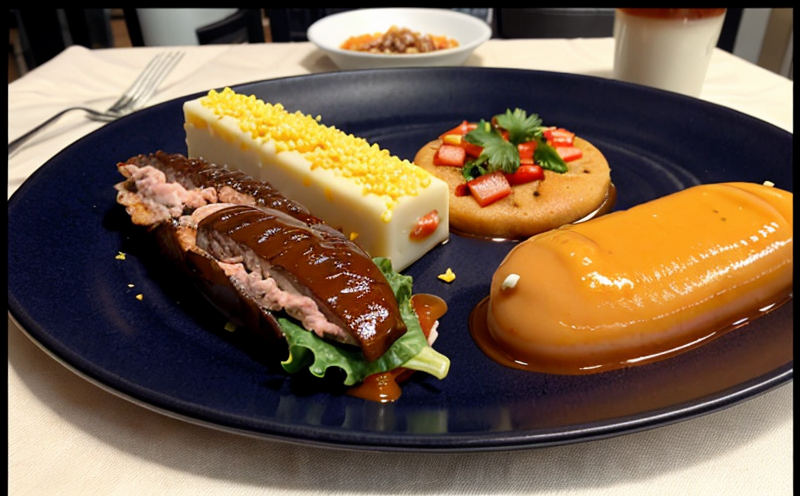EN 1186-7 Migration Test of Polycarbonate Materials
The EN 1186-7 standard provides a comprehensive framework for assessing the migration of substances from packaging materials into foodstuffs during storage and distribution. This is particularly critical for ensuring that polycarbonate materials used in packaging do not release harmful compounds that could adversely affect human health.
Polyacrylonitrile (PAN), also known as polycarbonate, is a widely used thermoplastic polymer due to its excellent mechanical properties, heat resistance, and clarity. However, the migration of certain chemicals from polycarbonate into food contact items can pose risks if not properly controlled.
The test method outlined in EN 1186-7 involves immersing the packaging material or product containing polycarbonate components in a defined food simulant solution for an extended period. The simulant mimics real-world conditions by replicating the temperature and chemical composition of different types of food. After the incubation, samples are analyzed to determine the presence and concentration of potentially harmful substances.
The test is particularly important because polycarbonate can release bisphenol A (BPA), a known endocrine disruptor. BPA has been linked to various health issues including reproductive disorders, developmental problems, and cardiovascular diseases. By adhering to EN 1186-7 standards, manufacturers ensure that their products meet stringent safety requirements set by regulatory bodies.
The testing procedure involves several critical steps:
- Selection of appropriate food simulants based on the type of food expected to come into contact with the packaging,
- Suspension or immersion of the polycarbonate sample in the selected simulant for a specified duration (typically 24 hours),
- Heating the container and its contents to simulate real-life storage conditions, often at temperatures between 30°C and 65°C depending on the type of food,
- Extraction of potential migrants using solvents or other appropriate methods,
- Analysis of the extracted substances via chromatography or other analytical techniques.
The results are compared against established limits for each detected compound. Compliance with these limits indicates that the packaging is safe for use in food contact applications.
This testing method plays a vital role in protecting consumers and ensuring compliance with international regulations such as those set forth by the European Union's Directive 2011/68/EU on Plastics Used in Food Contact. It helps manufacturers maintain their reputation for producing high-quality, safe products while avoiding costly recalls and legal challenges.
In summary, EN 1186-7 migration testing ensures that polycarbonate materials used in packaging do not contaminate foodstuffs with potentially harmful substances. This process is essential for maintaining public trust and ensuring adherence to strict safety standards.
Environmental and Sustainability Contributions
The use of polycarbonate in packaging can have both positive and negative impacts on the environment. On one hand, polycarbonate offers excellent recyclability due to its robust chemical resistance and mechanical properties. This makes it a preferable choice for certain types of packaging where durability is crucial.
However, improper disposal or recycling processes could lead to environmental concerns. For instance, if not managed correctly, the release of BPA during recycling can contaminate soil and water bodies. Therefore, adhering to rigorous testing protocols like EN 1186-7 helps minimize these risks by ensuring that only safe materials are used in packaging.
From a sustainability perspective, effective migration testing contributes to reducing waste by preventing the use of substandard or potentially harmful packaging materials. This not only protects public health but also reduces unnecessary resource consumption and pollution associated with product recalls or rejections.
By implementing robust testing procedures such as those specified in EN 1186-7, manufacturers contribute positively towards achieving broader sustainability goals by producing safer, more reliable products that meet stringent environmental standards. This aligns with global initiatives aimed at promoting sustainable development and responsible production practices.
Competitive Advantage and Market Impact
The implementation of EN 1186-7 migration testing provides significant competitive advantages for companies operating in the packaging industry, particularly those dealing with polycarbonate materials. Compliance with this standard demonstrates a company’s commitment to quality assurance and safety, which is increasingly becoming a key factor influencing consumer trust.
Consumers are becoming more aware of the potential risks associated with certain types of packaging materials, especially when it comes to food contact items. By ensuring that their products meet or exceed EN 1186-7 standards, companies can differentiate themselves from competitors who may not adhere to such stringent testing protocols.
This commitment also enhances a company's reputation in the market, making it easier to penetrate new markets and attract more customers. In today’s highly competitive global marketplace, maintaining high safety standards is essential for building long-term relationships with clients and stakeholders.
In addition, compliance with EN 1186-7 can help companies avoid costly legal issues related to product liability claims or recalls due to non-compliance. This reduces the risk of financial losses and reputational damage that could arise from selling unsafe products.
Furthermore, adhering to international standards like EN 1186-7 ensures consistency in testing methodologies across different regions, which facilitates smoother trade between countries with varying regulatory requirements. This harmonization simplifies compliance processes for multinational corporations operating globally.
In conclusion, the rigorous application of EN 1186-7 migration testing contributes significantly to a company’s competitive edge by fostering trust among consumers and stakeholders while minimizing potential risks associated with substandard packaging materials.
Use Cases and Application Examples
- Bottles for Beverage Packaging: Polycarbonate bottles are commonly used in the beverage industry due to their clear appearance, durability, and resistance to high temperatures. Testing these containers ensures that they do not leach harmful substances into the drink during storage or transportation.
- Cups for Coffee Shops: Many coffee shops use polycarbonate cups because of their ability to maintain heat retention without compromising safety. Migration testing helps ensure that these cups are free from hazardous chemicals, protecting both consumers and the environment.
- Baby Bottles and Nursing Accessories: Given the sensitive nature of products used by infants and young children, strict migration tests are essential to verify that polycarbonate components do not pose any risks. This includes testing pacifiers, bottles, nipples, and other accessories.





